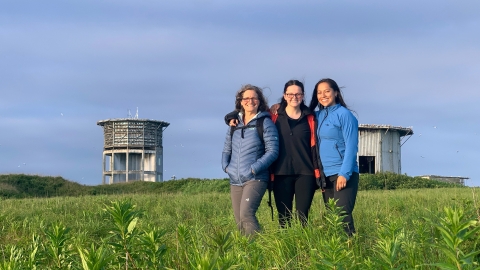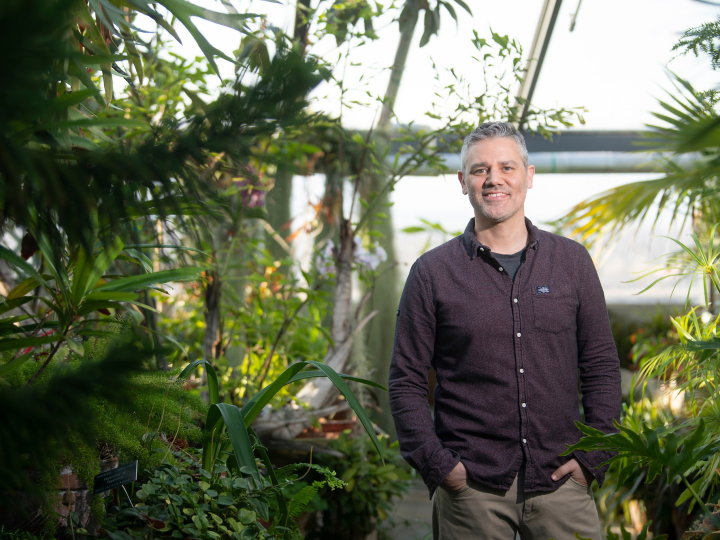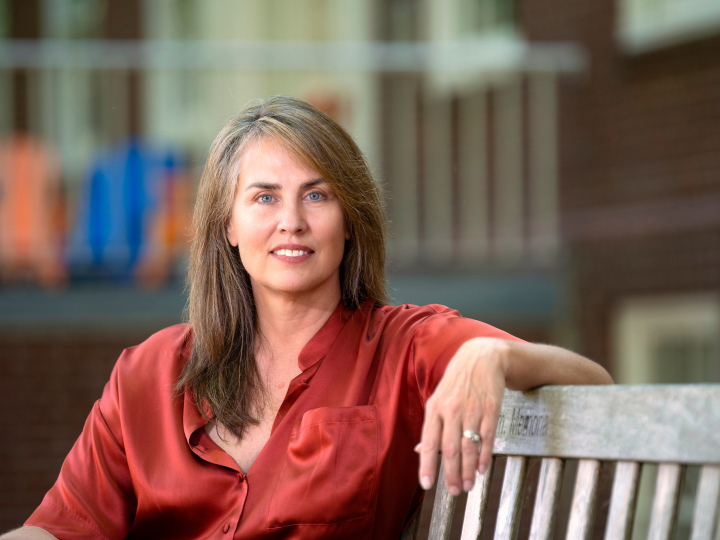
Seabirds as Sentinels: Bucknell Researchers Make 'National Geographic'
July 10, 2025
Professor Morgan Benowitz-Fredericks (left) and students Eadaoin Kelly '22 (center) and Sierra Pete M’23 (right) at the Middleton Island Marine Biological Station. Photo by Sierra Pete
Long before seabirds return to their cliffside nests each summer, they're already carrying a message — one that speaks to the health of the world's oceans. That message, decoded for nearly a decade by Bucknell University Professor Morgan Benowitz-Fredericks and her students, is now getting national attention.
Benowitz-Fredericks, biology, and director of Bucknell's animal behavior program, will be appearing with one of her former students, Sierra Pete M'23, in the August issue of National Geographic. The story explores how an abandoned military station in Alaska became an unlikely spot for seabird research, particularly for young scientists, offering a living link between ocean life and the scientists who study it — including those from Bucknell.
Morgan Heim, wildlife photographer who took the photos for the National Geographic story, takes a photo of Sierra Pete M'23 (right), assisting Chinatsu Nakajima, currently a Ph.D. student at Nagoya University, with a black-legged kittiwake. Photo by Morgan Benowitz-Fredericks
Since 2016, Benowitz-Fredericks has led student research at Middleton Island, a relatively flat outpost in the Gulf of Alaska. Once a military site, it's now a thriving seabird colony and home to the Middleton Island Marine Biological Station, managed by the Institute for Seabird Research and Conservation and used by teams of scientists from all over the world.
"The bigger field station is where all seabird research is conducted," Benowitz-Fredericks says. "The broad theme that unites all of us is understanding the relationship between the marine environment and wildlife."
Tracking black-legged kittiwakes
There, small gulls called black-legged kittiwakes (Rissa tridactyla) return each spring to breed — and bring with them insights from their daily journeys at sea. They have been the focus of the research conducted by Benowitz-Fredericks and students.
"They go out to sea every day and bring us back information," she says. "They're near the top of the marine ecosystem, and they come to land every year at the same site. That's rare — it gives us an opportunity that's incredibly valuable."
The research focuses on how environmental changes — from ocean temperatures to food availability — influence seabird physiology and behavior. Benowitz-Fredericks and her team participate in research that monitors levels of hormones and energy metabolites, helps track reproductive success, and even collects regurgitated stomach contents to analyze what the birds are eating. "The birds puke when you handle them," she says. "We freeze it, date it, and my colleagues identify the prey species in it to document what's changing in the ocean across breeding seasons and between years. There's no other way to get that kind of data."
Sierra Pete M'23 (front) and field technician Stella Solasz handle a black-legged kittiwake. Photo by Morgan Benowitz-Fredericks
One key research tool: an old Air Force tower that's been modified so that researchers can monitor behavior or lift a window and gently reach out to grab a tagged bird.
"Every bird is marked and monitored," she says. "Biology is happening at every level — survival, birth rates, evolution. It's also just really fun science. And it creates a tight-knit, international community of young scientists from Canada, Japan, France, Italy, United Kingdom and the U.S."
That experience is part of what drew Benowitz-Fredericks into wildlife biology — and what she hopes to pass on to her students.
Charting climate change
But island life is changing. Summers are hotter and drier, and that's taking a toll on the birds.
"Three years ago, we started finding birds with neurological damage," Benowitz-Fredericks says. "It turned out to be a form of botulism that forms in low-oxygen water. The freshwater ponds were hot and stagnant. We started running out of drinking water. It had never been a problem before."
These changes — from heat stress to food scarcity — are altering seabird behavior in visible and invisible ways. Using GPS trackers, Middleton researchers follow where birds forage and correlate those trips with what they've eaten. In some nests, the older chick may even attack its sibling — a behavior known as siblicide. Benowitz-Fredericks and her students are studying whether hormones or parental responses play a role.
"We're trying to understand why in some nests the chicks snuggle, and in others, the younger chick gets attacked," she says. "It even happens in experimentally food-supplemented nests. We think hormones might influence that aggression early — maybe even on the day the chick hatches."
Long-term supplemental feeding experiments — delivering fish by hand three times a day to 75 nests for the entire summer — help isolate the role of food in reproduction.
"Food regulates so much of animal behavior," she says. "And what we're seeing is that decisions about how to invest in the breeding season may be made over the winter. What happens out at sea carries over into everything."
For Benowitz-Fredericks, that connection — from ocean to bird to biology student — is what makes Middleton Island extraordinary. "There's nowhere in the world like this site," she says. "The seabirds show us what's happening in places we can't see. And we're lucky enough to be there to listen."

